Strategic Leadership and Organisational Transformation at Unilever
VerifiedAdded on 2021/02/20
|14
|3309
|51
Report
AI Summary
This report provides a comprehensive analysis of Unilever's digital transformation, examining the company's shift towards AI and new technologies. It explores the reasons behind the change, including the need to enhance digital capabilities, gain a competitive edge, and improve customer data management. The report delves into the nature of the change, classifying it as transformational, and discusses relevant change management models, such as Lewin's and Kotter's, illustrating how Unilever implemented these models to manage the transition. It also analyzes the forces driving the change using force field analysis, considering both driving and restraining factors. Furthermore, the report addresses the company's approach towards change, including resistance and the PDCA cycle, and highlights the role of leadership in driving the transformation and its positive effects. The report concludes by emphasizing the importance of strategic leadership and effective change management in achieving organizational goals in the digital age.
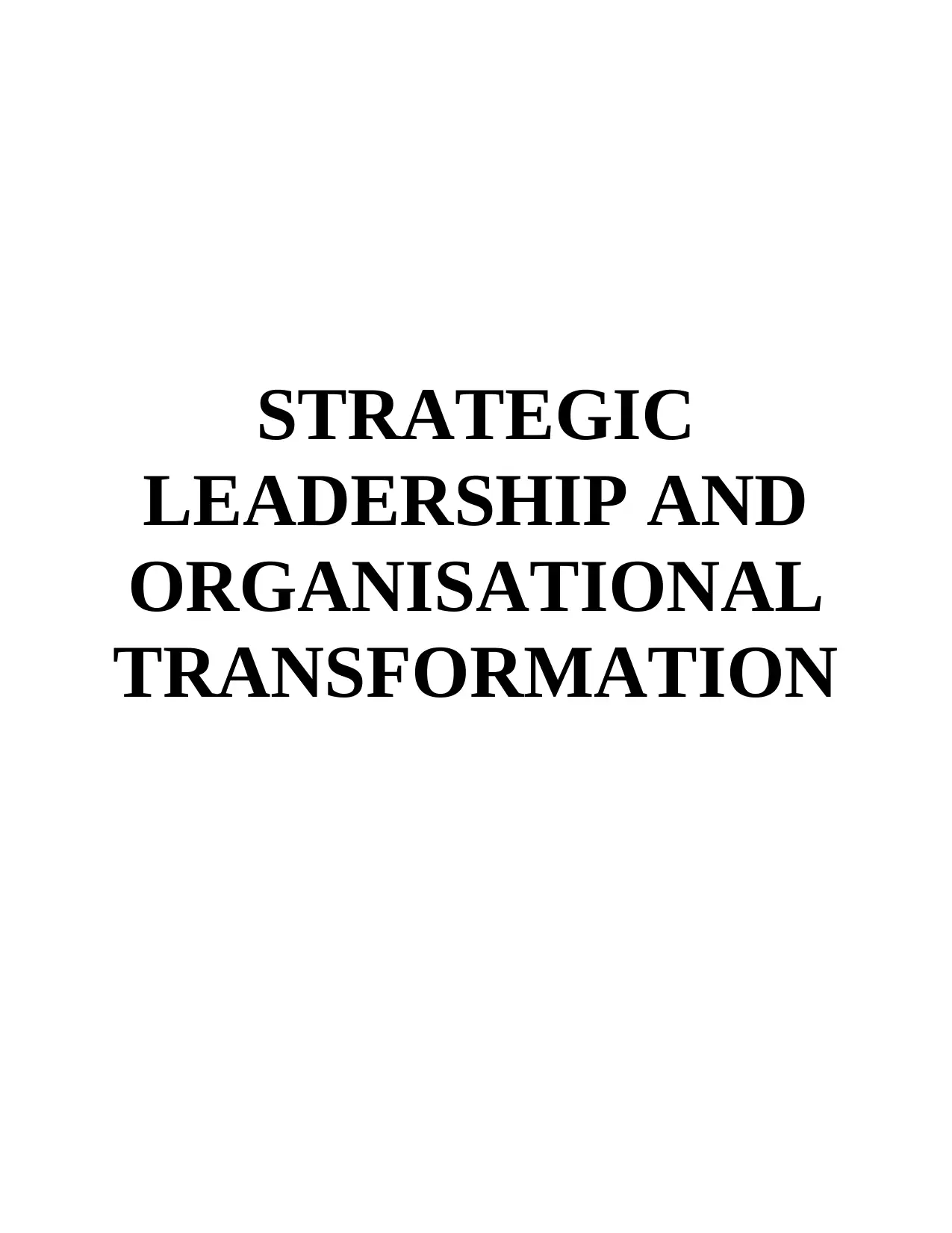
STRATEGIC
LEADERSHIP AND
ORGANISATIONAL
TRANSFORMATION
LEADERSHIP AND
ORGANISATIONAL
TRANSFORMATION
Paraphrase This Document
Need a fresh take? Get an instant paraphrase of this document with our AI Paraphraser
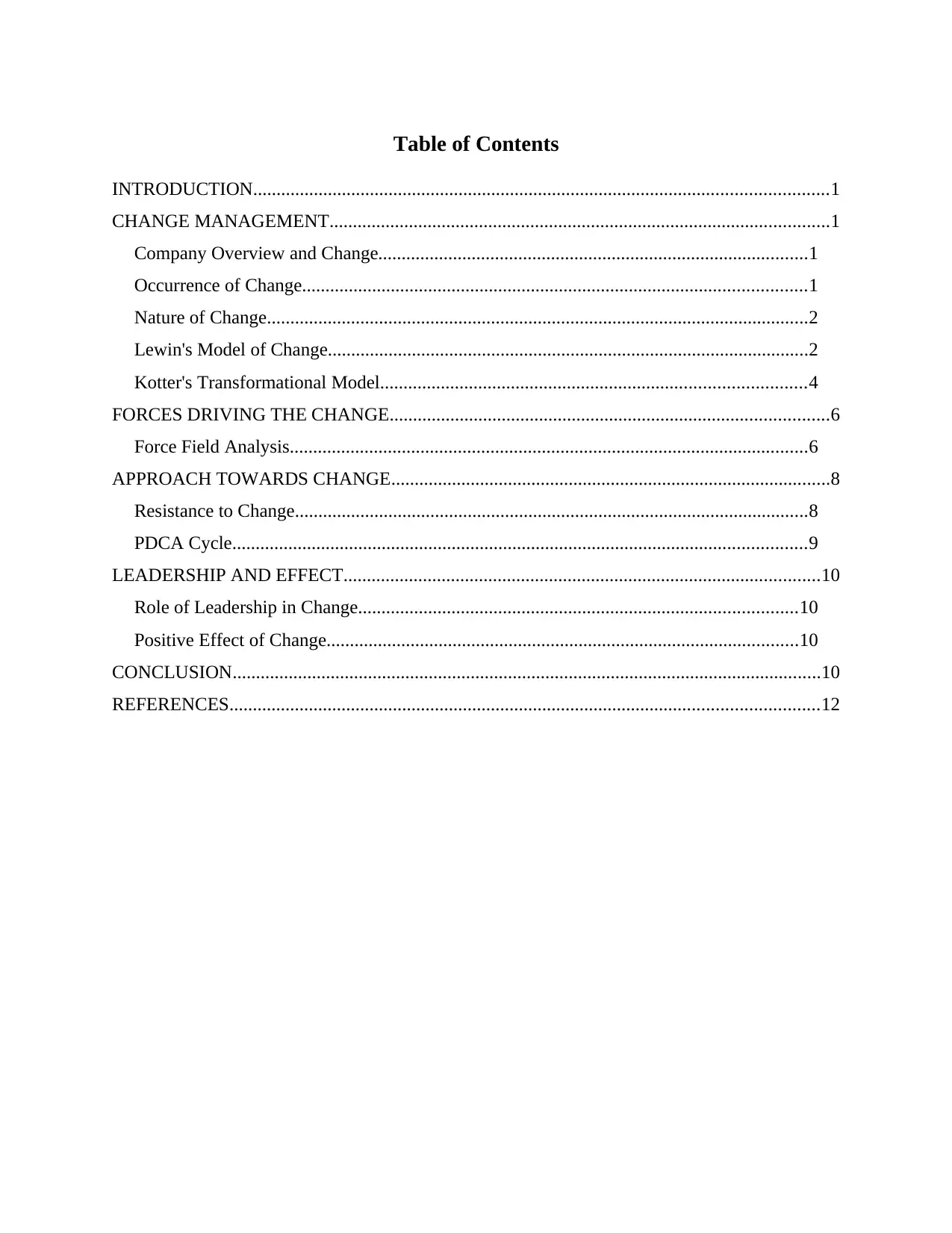
Table of Contents
INTRODUCTION...........................................................................................................................1
CHANGE MANAGEMENT...........................................................................................................1
Company Overview and Change............................................................................................1
Occurrence of Change............................................................................................................1
Nature of Change....................................................................................................................2
Lewin's Model of Change.......................................................................................................2
Kotter's Transformational Model...........................................................................................4
FORCES DRIVING THE CHANGE..............................................................................................6
Force Field Analysis...............................................................................................................6
APPROACH TOWARDS CHANGE..............................................................................................8
Resistance to Change..............................................................................................................8
PDCA Cycle...........................................................................................................................9
LEADERSHIP AND EFFECT......................................................................................................10
Role of Leadership in Change..............................................................................................10
Positive Effect of Change.....................................................................................................10
CONCLUSION..............................................................................................................................10
REFERENCES..............................................................................................................................12
INTRODUCTION...........................................................................................................................1
CHANGE MANAGEMENT...........................................................................................................1
Company Overview and Change............................................................................................1
Occurrence of Change............................................................................................................1
Nature of Change....................................................................................................................2
Lewin's Model of Change.......................................................................................................2
Kotter's Transformational Model...........................................................................................4
FORCES DRIVING THE CHANGE..............................................................................................6
Force Field Analysis...............................................................................................................6
APPROACH TOWARDS CHANGE..............................................................................................8
Resistance to Change..............................................................................................................8
PDCA Cycle...........................................................................................................................9
LEADERSHIP AND EFFECT......................................................................................................10
Role of Leadership in Change..............................................................................................10
Positive Effect of Change.....................................................................................................10
CONCLUSION..............................................................................................................................10
REFERENCES..............................................................................................................................12
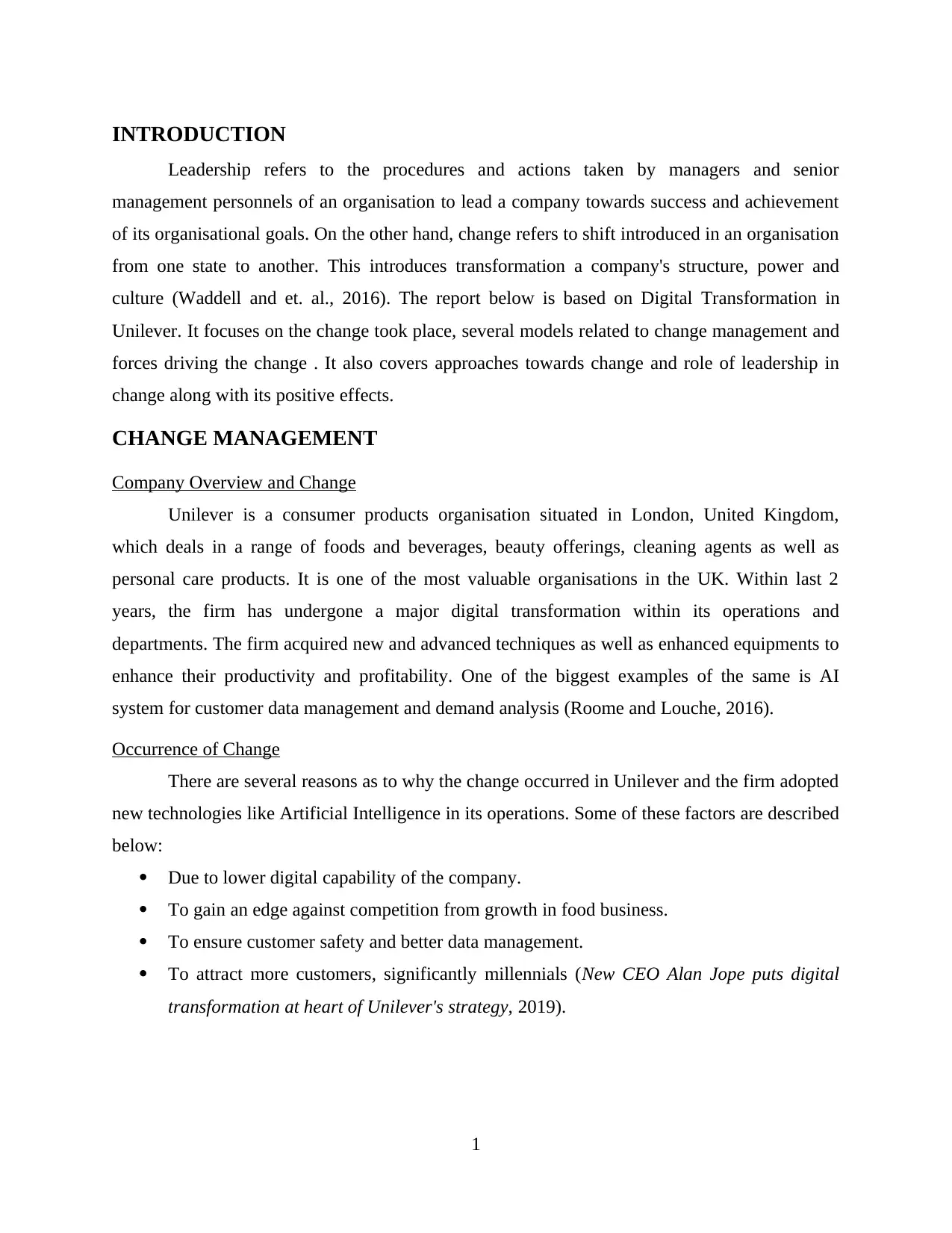
INTRODUCTION
Leadership refers to the procedures and actions taken by managers and senior
management personnels of an organisation to lead a company towards success and achievement
of its organisational goals. On the other hand, change refers to shift introduced in an organisation
from one state to another. This introduces transformation a company's structure, power and
culture (Waddell and et. al., 2016). The report below is based on Digital Transformation in
Unilever. It focuses on the change took place, several models related to change management and
forces driving the change . It also covers approaches towards change and role of leadership in
change along with its positive effects.
CHANGE MANAGEMENT
Company Overview and Change
Unilever is a consumer products organisation situated in London, United Kingdom,
which deals in a range of foods and beverages, beauty offerings, cleaning agents as well as
personal care products. It is one of the most valuable organisations in the UK. Within last 2
years, the firm has undergone a major digital transformation within its operations and
departments. The firm acquired new and advanced techniques as well as enhanced equipments to
enhance their productivity and profitability. One of the biggest examples of the same is AI
system for customer data management and demand analysis (Roome and Louche, 2016).
Occurrence of Change
There are several reasons as to why the change occurred in Unilever and the firm adopted
new technologies like Artificial Intelligence in its operations. Some of these factors are described
below:
Due to lower digital capability of the company.
To gain an edge against competition from growth in food business.
To ensure customer safety and better data management.
To attract more customers, significantly millennials (New CEO Alan Jope puts digital
transformation at heart of Unilever's strategy, 2019).
1
Leadership refers to the procedures and actions taken by managers and senior
management personnels of an organisation to lead a company towards success and achievement
of its organisational goals. On the other hand, change refers to shift introduced in an organisation
from one state to another. This introduces transformation a company's structure, power and
culture (Waddell and et. al., 2016). The report below is based on Digital Transformation in
Unilever. It focuses on the change took place, several models related to change management and
forces driving the change . It also covers approaches towards change and role of leadership in
change along with its positive effects.
CHANGE MANAGEMENT
Company Overview and Change
Unilever is a consumer products organisation situated in London, United Kingdom,
which deals in a range of foods and beverages, beauty offerings, cleaning agents as well as
personal care products. It is one of the most valuable organisations in the UK. Within last 2
years, the firm has undergone a major digital transformation within its operations and
departments. The firm acquired new and advanced techniques as well as enhanced equipments to
enhance their productivity and profitability. One of the biggest examples of the same is AI
system for customer data management and demand analysis (Roome and Louche, 2016).
Occurrence of Change
There are several reasons as to why the change occurred in Unilever and the firm adopted
new technologies like Artificial Intelligence in its operations. Some of these factors are described
below:
Due to lower digital capability of the company.
To gain an edge against competition from growth in food business.
To ensure customer safety and better data management.
To attract more customers, significantly millennials (New CEO Alan Jope puts digital
transformation at heart of Unilever's strategy, 2019).
1
⊘ This is a preview!⊘
Do you want full access?
Subscribe today to unlock all pages.

Trusted by 1+ million students worldwide
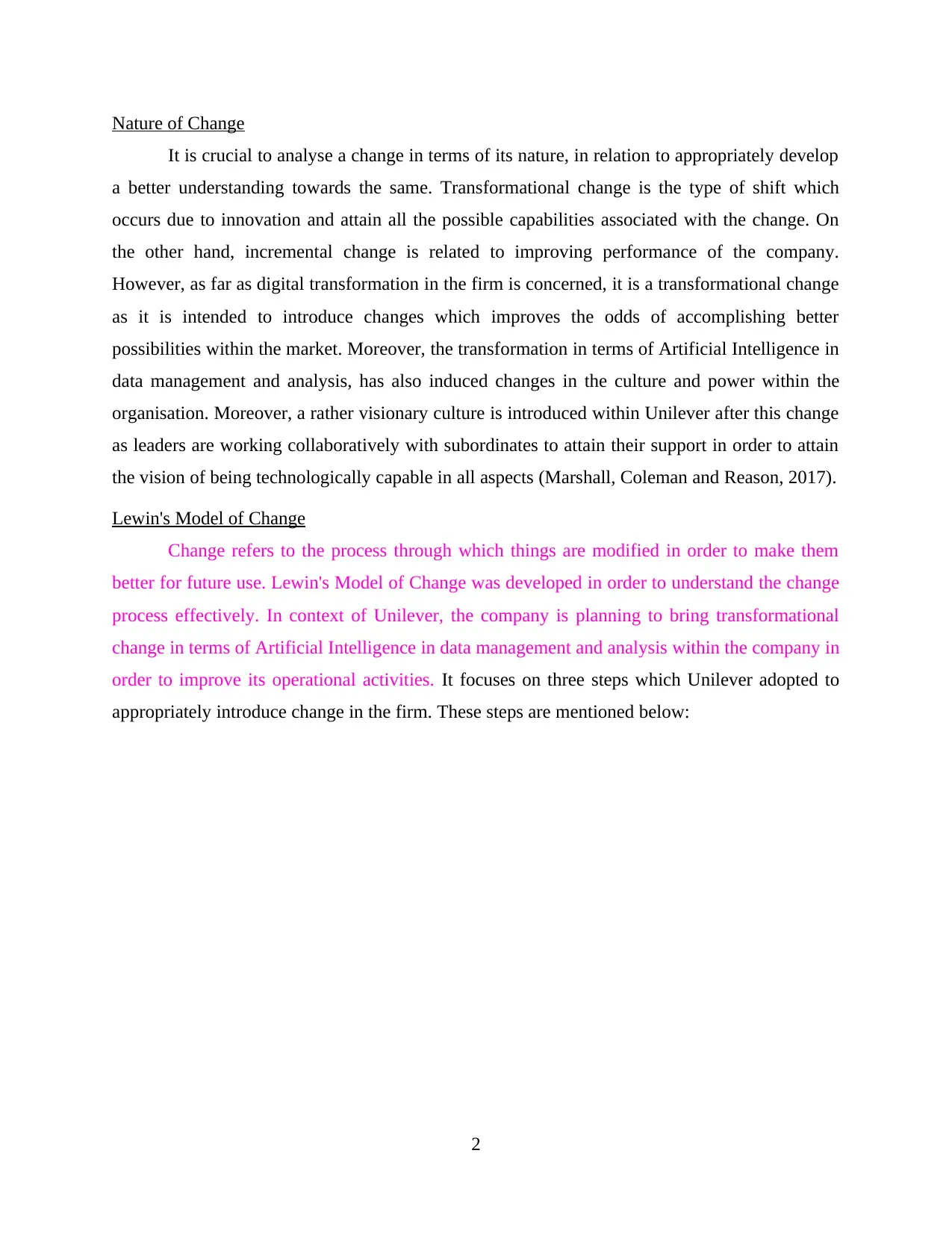
Nature of Change
It is crucial to analyse a change in terms of its nature, in relation to appropriately develop
a better understanding towards the same. Transformational change is the type of shift which
occurs due to innovation and attain all the possible capabilities associated with the change. On
the other hand, incremental change is related to improving performance of the company.
However, as far as digital transformation in the firm is concerned, it is a transformational change
as it is intended to introduce changes which improves the odds of accomplishing better
possibilities within the market. Moreover, the transformation in terms of Artificial Intelligence in
data management and analysis, has also induced changes in the culture and power within the
organisation. Moreover, a rather visionary culture is introduced within Unilever after this change
as leaders are working collaboratively with subordinates to attain their support in order to attain
the vision of being technologically capable in all aspects (Marshall, Coleman and Reason, 2017).
Lewin's Model of Change
Change refers to the process through which things are modified in order to make them
better for future use. Lewin's Model of Change was developed in order to understand the change
process effectively. In context of Unilever, the company is planning to bring transformational
change in terms of Artificial Intelligence in data management and analysis within the company in
order to improve its operational activities. It focuses on three steps which Unilever adopted to
appropriately introduce change in the firm. These steps are mentioned below:
2
It is crucial to analyse a change in terms of its nature, in relation to appropriately develop
a better understanding towards the same. Transformational change is the type of shift which
occurs due to innovation and attain all the possible capabilities associated with the change. On
the other hand, incremental change is related to improving performance of the company.
However, as far as digital transformation in the firm is concerned, it is a transformational change
as it is intended to introduce changes which improves the odds of accomplishing better
possibilities within the market. Moreover, the transformation in terms of Artificial Intelligence in
data management and analysis, has also induced changes in the culture and power within the
organisation. Moreover, a rather visionary culture is introduced within Unilever after this change
as leaders are working collaboratively with subordinates to attain their support in order to attain
the vision of being technologically capable in all aspects (Marshall, Coleman and Reason, 2017).
Lewin's Model of Change
Change refers to the process through which things are modified in order to make them
better for future use. Lewin's Model of Change was developed in order to understand the change
process effectively. In context of Unilever, the company is planning to bring transformational
change in terms of Artificial Intelligence in data management and analysis within the company in
order to improve its operational activities. It focuses on three steps which Unilever adopted to
appropriately introduce change in the firm. These steps are mentioned below:
2
Paraphrase This Document
Need a fresh take? Get an instant paraphrase of this document with our AI Paraphraser
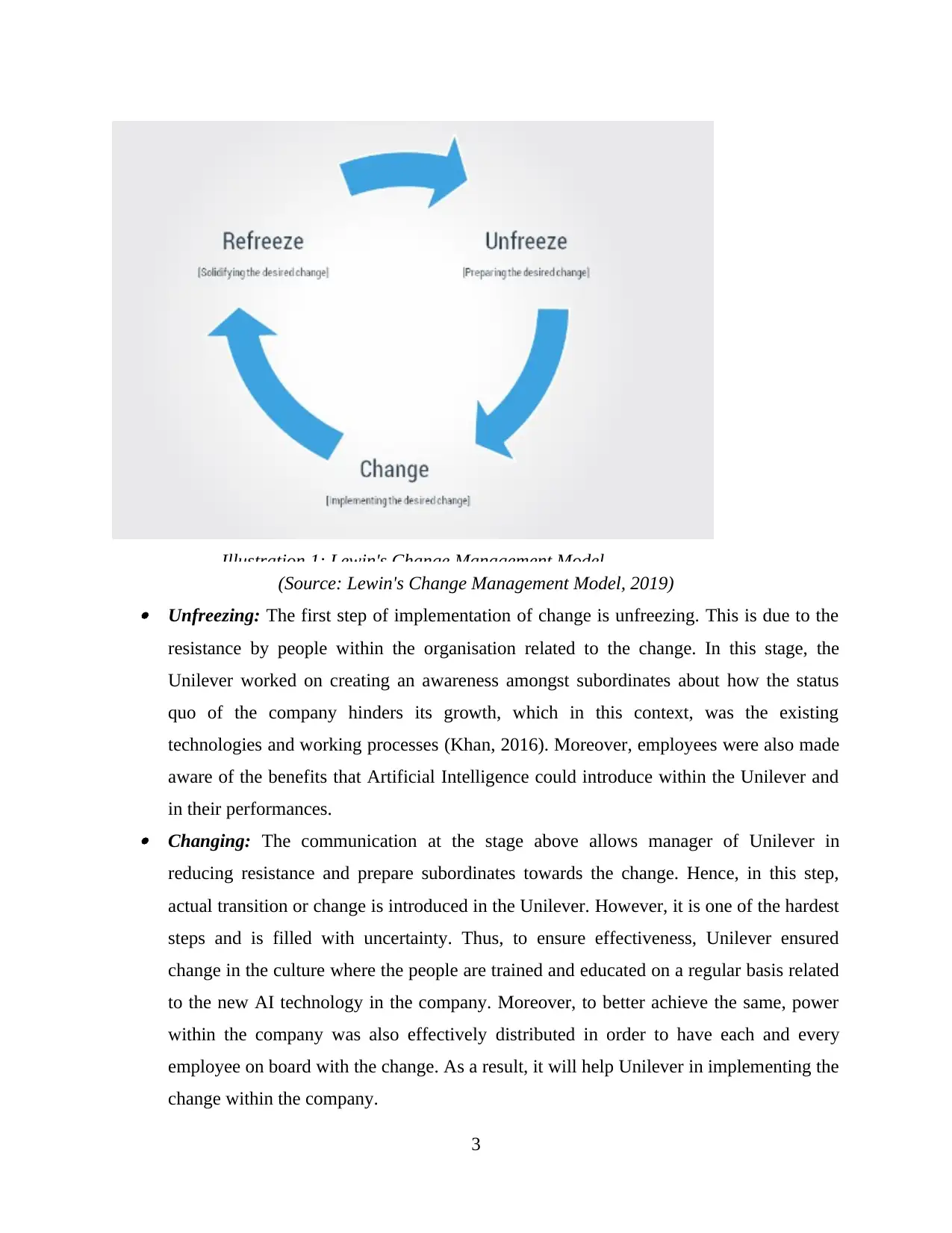
Illustration 1: Lewin's Change Management Model
(Source: Lewin's Change Management Model, 2019) Unfreezing: The first step of implementation of change is unfreezing. This is due to the
resistance by people within the organisation related to the change. In this stage, the
Unilever worked on creating an awareness amongst subordinates about how the status
quo of the company hinders its growth, which in this context, was the existing
technologies and working processes (Khan, 2016). Moreover, employees were also made
aware of the benefits that Artificial Intelligence could introduce within the Unilever and
in their performances. Changing: The communication at the stage above allows manager of Unilever in
reducing resistance and prepare subordinates towards the change. Hence, in this step,
actual transition or change is introduced in the Unilever. However, it is one of the hardest
steps and is filled with uncertainty. Thus, to ensure effectiveness, Unilever ensured
change in the culture where the people are trained and educated on a regular basis related
to the new AI technology in the company. Moreover, to better achieve the same, power
within the company was also effectively distributed in order to have each and every
employee on board with the change. As a result, it will help Unilever in implementing the
change within the company.
3
(Source: Lewin's Change Management Model, 2019) Unfreezing: The first step of implementation of change is unfreezing. This is due to the
resistance by people within the organisation related to the change. In this stage, the
Unilever worked on creating an awareness amongst subordinates about how the status
quo of the company hinders its growth, which in this context, was the existing
technologies and working processes (Khan, 2016). Moreover, employees were also made
aware of the benefits that Artificial Intelligence could introduce within the Unilever and
in their performances. Changing: The communication at the stage above allows manager of Unilever in
reducing resistance and prepare subordinates towards the change. Hence, in this step,
actual transition or change is introduced in the Unilever. However, it is one of the hardest
steps and is filled with uncertainty. Thus, to ensure effectiveness, Unilever ensured
change in the culture where the people are trained and educated on a regular basis related
to the new AI technology in the company. Moreover, to better achieve the same, power
within the company was also effectively distributed in order to have each and every
employee on board with the change. As a result, it will help Unilever in implementing the
change within the company.
3
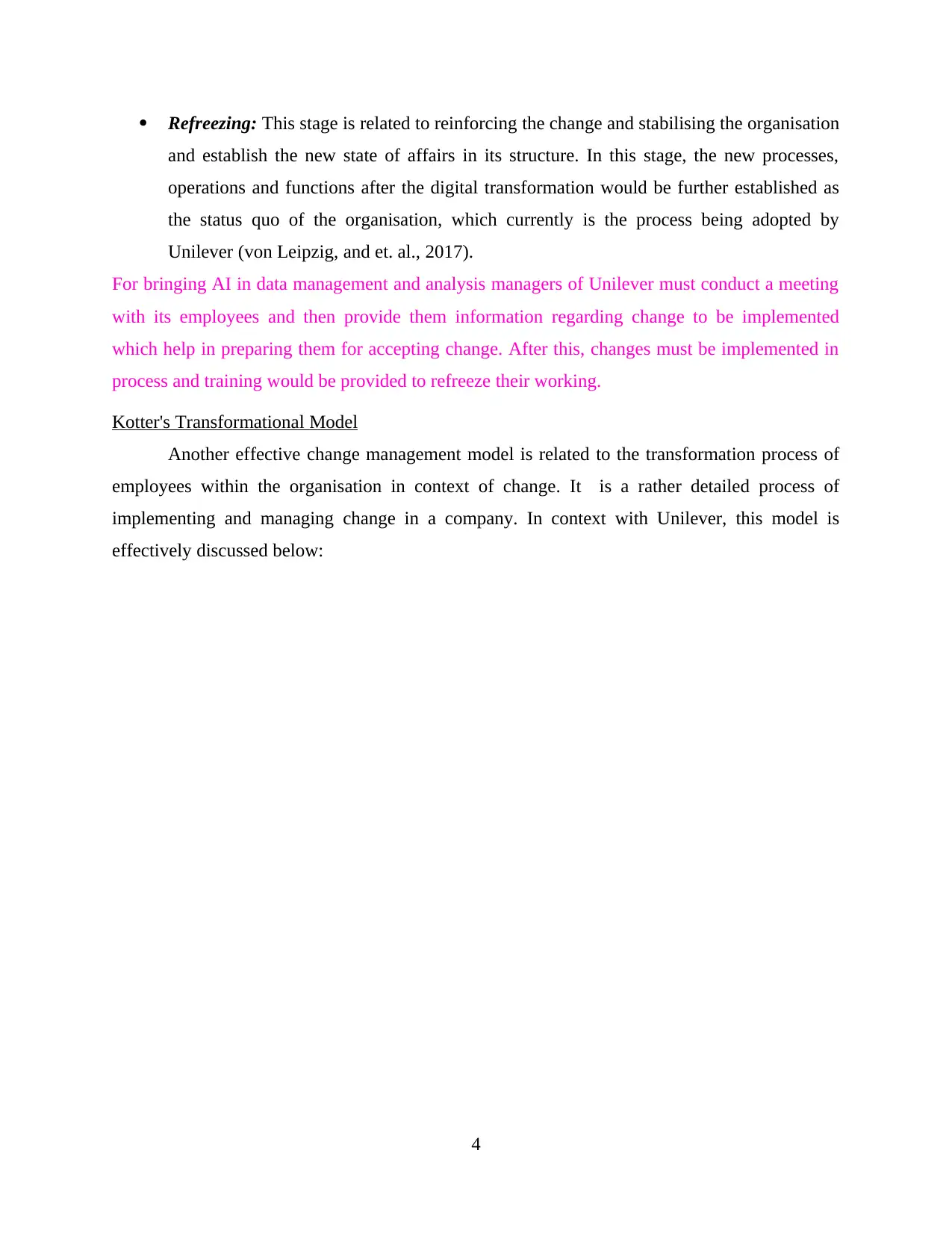
Refreezing: This stage is related to reinforcing the change and stabilising the organisation
and establish the new state of affairs in its structure. In this stage, the new processes,
operations and functions after the digital transformation would be further established as
the status quo of the organisation, which currently is the process being adopted by
Unilever (von Leipzig, and et. al., 2017).
For bringing AI in data management and analysis managers of Unilever must conduct a meeting
with its employees and then provide them information regarding change to be implemented
which help in preparing them for accepting change. After this, changes must be implemented in
process and training would be provided to refreeze their working.
Kotter's Transformational Model
Another effective change management model is related to the transformation process of
employees within the organisation in context of change. It is a rather detailed process of
implementing and managing change in a company. In context with Unilever, this model is
effectively discussed below:
4
and establish the new state of affairs in its structure. In this stage, the new processes,
operations and functions after the digital transformation would be further established as
the status quo of the organisation, which currently is the process being adopted by
Unilever (von Leipzig, and et. al., 2017).
For bringing AI in data management and analysis managers of Unilever must conduct a meeting
with its employees and then provide them information regarding change to be implemented
which help in preparing them for accepting change. After this, changes must be implemented in
process and training would be provided to refreeze their working.
Kotter's Transformational Model
Another effective change management model is related to the transformation process of
employees within the organisation in context of change. It is a rather detailed process of
implementing and managing change in a company. In context with Unilever, this model is
effectively discussed below:
4
⊘ This is a preview!⊘
Do you want full access?
Subscribe today to unlock all pages.

Trusted by 1+ million students worldwide
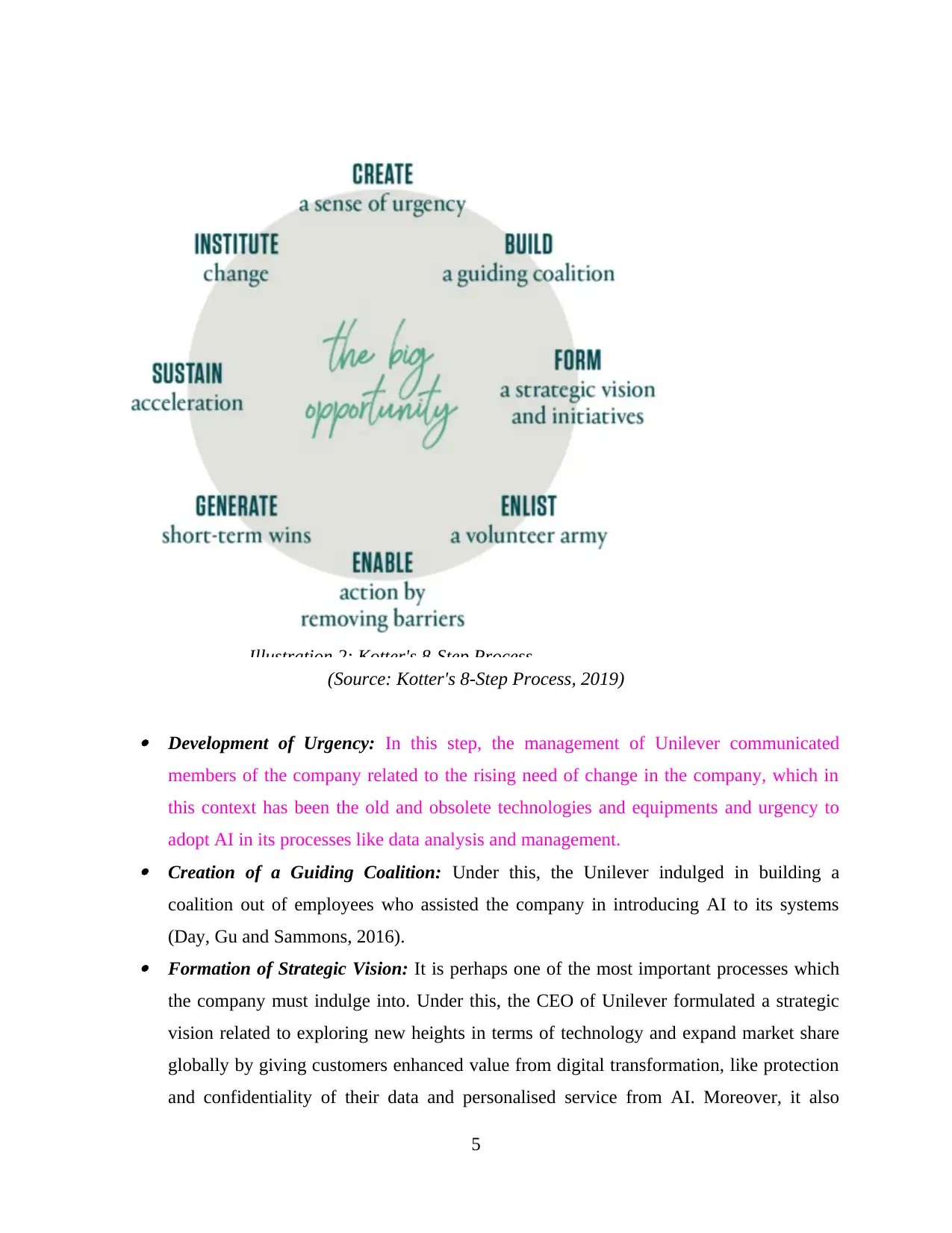
Illustration 2: Kotter's 8-Step Process
(Source: Kotter's 8-Step Process, 2019)
Development of Urgency: In this step, the management of Unilever communicated
members of the company related to the rising need of change in the company, which in
this context has been the old and obsolete technologies and equipments and urgency to
adopt AI in its processes like data analysis and management. Creation of a Guiding Coalition: Under this, the Unilever indulged in building a
coalition out of employees who assisted the company in introducing AI to its systems
(Day, Gu and Sammons, 2016). Formation of Strategic Vision: It is perhaps one of the most important processes which
the company must indulge into. Under this, the CEO of Unilever formulated a strategic
vision related to exploring new heights in terms of technology and expand market share
globally by giving customers enhanced value from digital transformation, like protection
and confidentiality of their data and personalised service from AI. Moreover, it also
5
(Source: Kotter's 8-Step Process, 2019)
Development of Urgency: In this step, the management of Unilever communicated
members of the company related to the rising need of change in the company, which in
this context has been the old and obsolete technologies and equipments and urgency to
adopt AI in its processes like data analysis and management. Creation of a Guiding Coalition: Under this, the Unilever indulged in building a
coalition out of employees who assisted the company in introducing AI to its systems
(Day, Gu and Sammons, 2016). Formation of Strategic Vision: It is perhaps one of the most important processes which
the company must indulge into. Under this, the CEO of Unilever formulated a strategic
vision related to exploring new heights in terms of technology and expand market share
globally by giving customers enhanced value from digital transformation, like protection
and confidentiality of their data and personalised service from AI. Moreover, it also
5
Paraphrase This Document
Need a fresh take? Get an instant paraphrase of this document with our AI Paraphraser
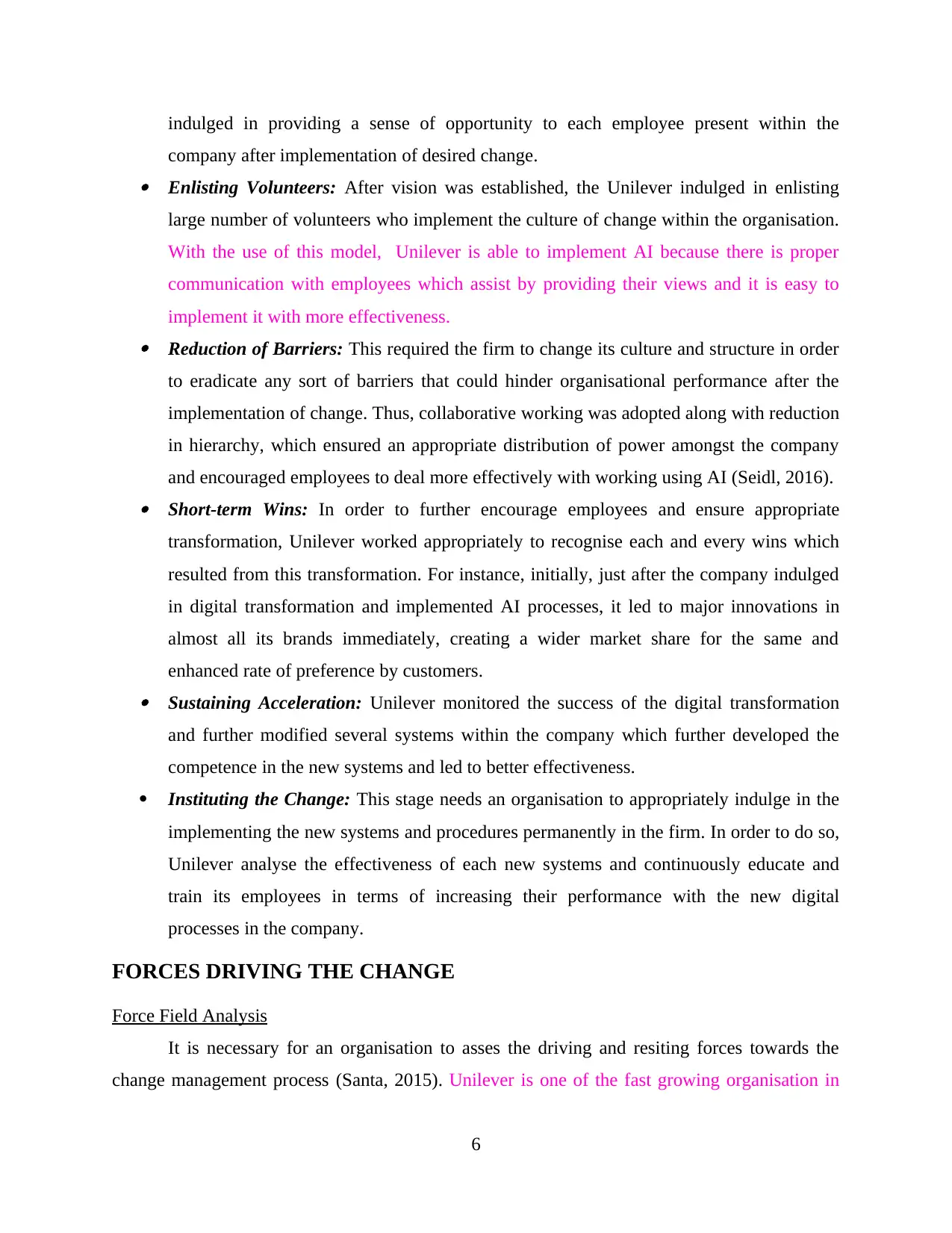
indulged in providing a sense of opportunity to each employee present within the
company after implementation of desired change. Enlisting Volunteers: After vision was established, the Unilever indulged in enlisting
large number of volunteers who implement the culture of change within the organisation.
With the use of this model, Unilever is able to implement AI because there is proper
communication with employees which assist by providing their views and it is easy to
implement it with more effectiveness. Reduction of Barriers: This required the firm to change its culture and structure in order
to eradicate any sort of barriers that could hinder organisational performance after the
implementation of change. Thus, collaborative working was adopted along with reduction
in hierarchy, which ensured an appropriate distribution of power amongst the company
and encouraged employees to deal more effectively with working using AI (Seidl, 2016). Short-term Wins: In order to further encourage employees and ensure appropriate
transformation, Unilever worked appropriately to recognise each and every wins which
resulted from this transformation. For instance, initially, just after the company indulged
in digital transformation and implemented AI processes, it led to major innovations in
almost all its brands immediately, creating a wider market share for the same and
enhanced rate of preference by customers. Sustaining Acceleration: Unilever monitored the success of the digital transformation
and further modified several systems within the company which further developed the
competence in the new systems and led to better effectiveness.
Instituting the Change: This stage needs an organisation to appropriately indulge in the
implementing the new systems and procedures permanently in the firm. In order to do so,
Unilever analyse the effectiveness of each new systems and continuously educate and
train its employees in terms of increasing their performance with the new digital
processes in the company.
FORCES DRIVING THE CHANGE
Force Field Analysis
It is necessary for an organisation to asses the driving and resiting forces towards the
change management process (Santa, 2015). Unilever is one of the fast growing organisation in
6
company after implementation of desired change. Enlisting Volunteers: After vision was established, the Unilever indulged in enlisting
large number of volunteers who implement the culture of change within the organisation.
With the use of this model, Unilever is able to implement AI because there is proper
communication with employees which assist by providing their views and it is easy to
implement it with more effectiveness. Reduction of Barriers: This required the firm to change its culture and structure in order
to eradicate any sort of barriers that could hinder organisational performance after the
implementation of change. Thus, collaborative working was adopted along with reduction
in hierarchy, which ensured an appropriate distribution of power amongst the company
and encouraged employees to deal more effectively with working using AI (Seidl, 2016). Short-term Wins: In order to further encourage employees and ensure appropriate
transformation, Unilever worked appropriately to recognise each and every wins which
resulted from this transformation. For instance, initially, just after the company indulged
in digital transformation and implemented AI processes, it led to major innovations in
almost all its brands immediately, creating a wider market share for the same and
enhanced rate of preference by customers. Sustaining Acceleration: Unilever monitored the success of the digital transformation
and further modified several systems within the company which further developed the
competence in the new systems and led to better effectiveness.
Instituting the Change: This stage needs an organisation to appropriately indulge in the
implementing the new systems and procedures permanently in the firm. In order to do so,
Unilever analyse the effectiveness of each new systems and continuously educate and
train its employees in terms of increasing their performance with the new digital
processes in the company.
FORCES DRIVING THE CHANGE
Force Field Analysis
It is necessary for an organisation to asses the driving and resiting forces towards the
change management process (Santa, 2015). Unilever is one of the fast growing organisation in
6
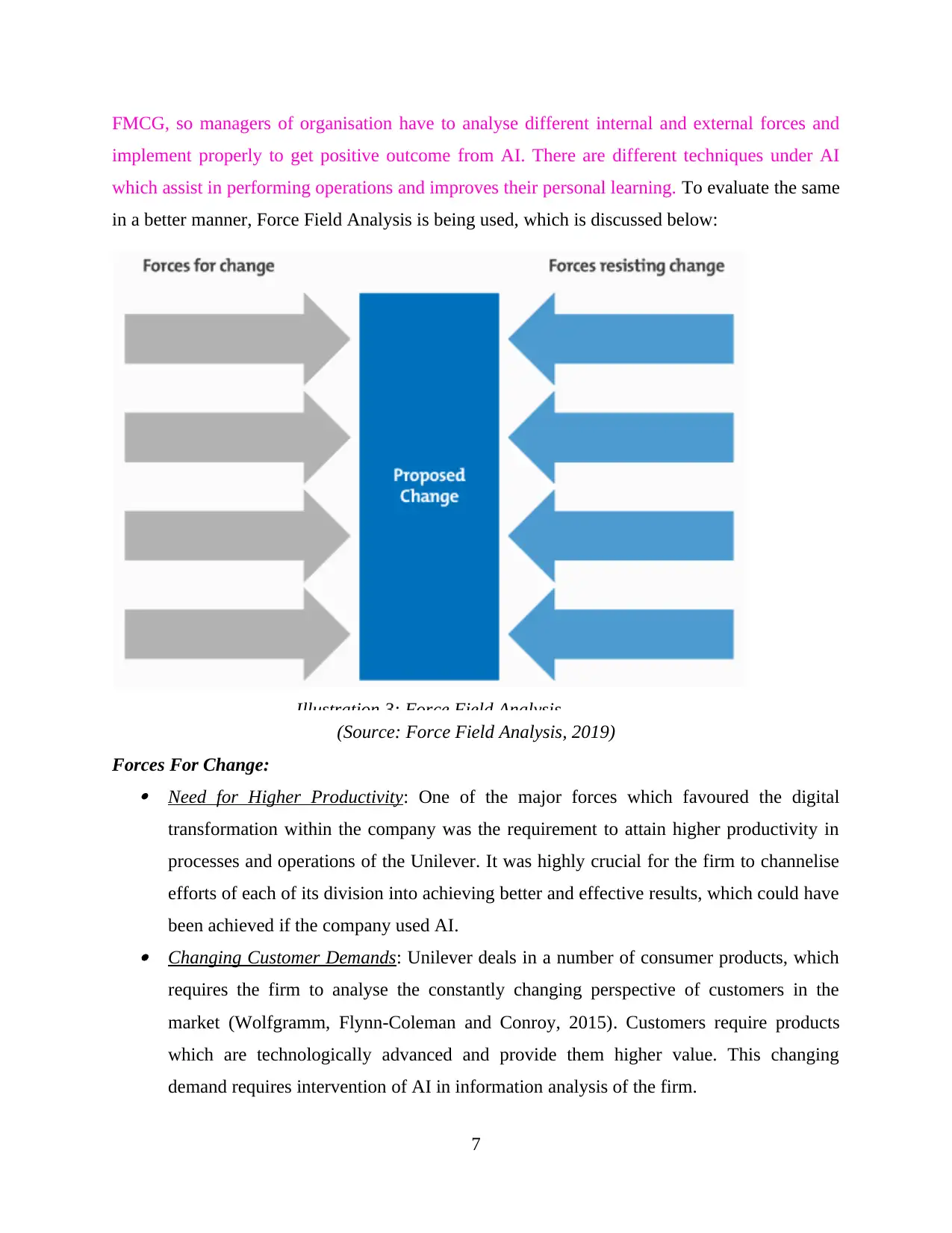
FMCG, so managers of organisation have to analyse different internal and external forces and
implement properly to get positive outcome from AI. There are different techniques under AI
which assist in performing operations and improves their personal learning. To evaluate the same
in a better manner, Force Field Analysis is being used, which is discussed below:
Illustration 3: Force Field Analysis
(Source: Force Field Analysis, 2019)
Forces For Change: Need for Higher Productivity: One of the major forces which favoured the digital
transformation within the company was the requirement to attain higher productivity in
processes and operations of the Unilever. It was highly crucial for the firm to channelise
efforts of each of its division into achieving better and effective results, which could have
been achieved if the company used AI. Changing Customer Demands: Unilever deals in a number of consumer products, which
requires the firm to analyse the constantly changing perspective of customers in the
market (Wolfgramm, Flynn-Coleman and Conroy, 2015). Customers require products
which are technologically advanced and provide them higher value. This changing
demand requires intervention of AI in information analysis of the firm.
7
implement properly to get positive outcome from AI. There are different techniques under AI
which assist in performing operations and improves their personal learning. To evaluate the same
in a better manner, Force Field Analysis is being used, which is discussed below:
Illustration 3: Force Field Analysis
(Source: Force Field Analysis, 2019)
Forces For Change: Need for Higher Productivity: One of the major forces which favoured the digital
transformation within the company was the requirement to attain higher productivity in
processes and operations of the Unilever. It was highly crucial for the firm to channelise
efforts of each of its division into achieving better and effective results, which could have
been achieved if the company used AI. Changing Customer Demands: Unilever deals in a number of consumer products, which
requires the firm to analyse the constantly changing perspective of customers in the
market (Wolfgramm, Flynn-Coleman and Conroy, 2015). Customers require products
which are technologically advanced and provide them higher value. This changing
demand requires intervention of AI in information analysis of the firm.
7
⊘ This is a preview!⊘
Do you want full access?
Subscribe today to unlock all pages.

Trusted by 1+ million students worldwide
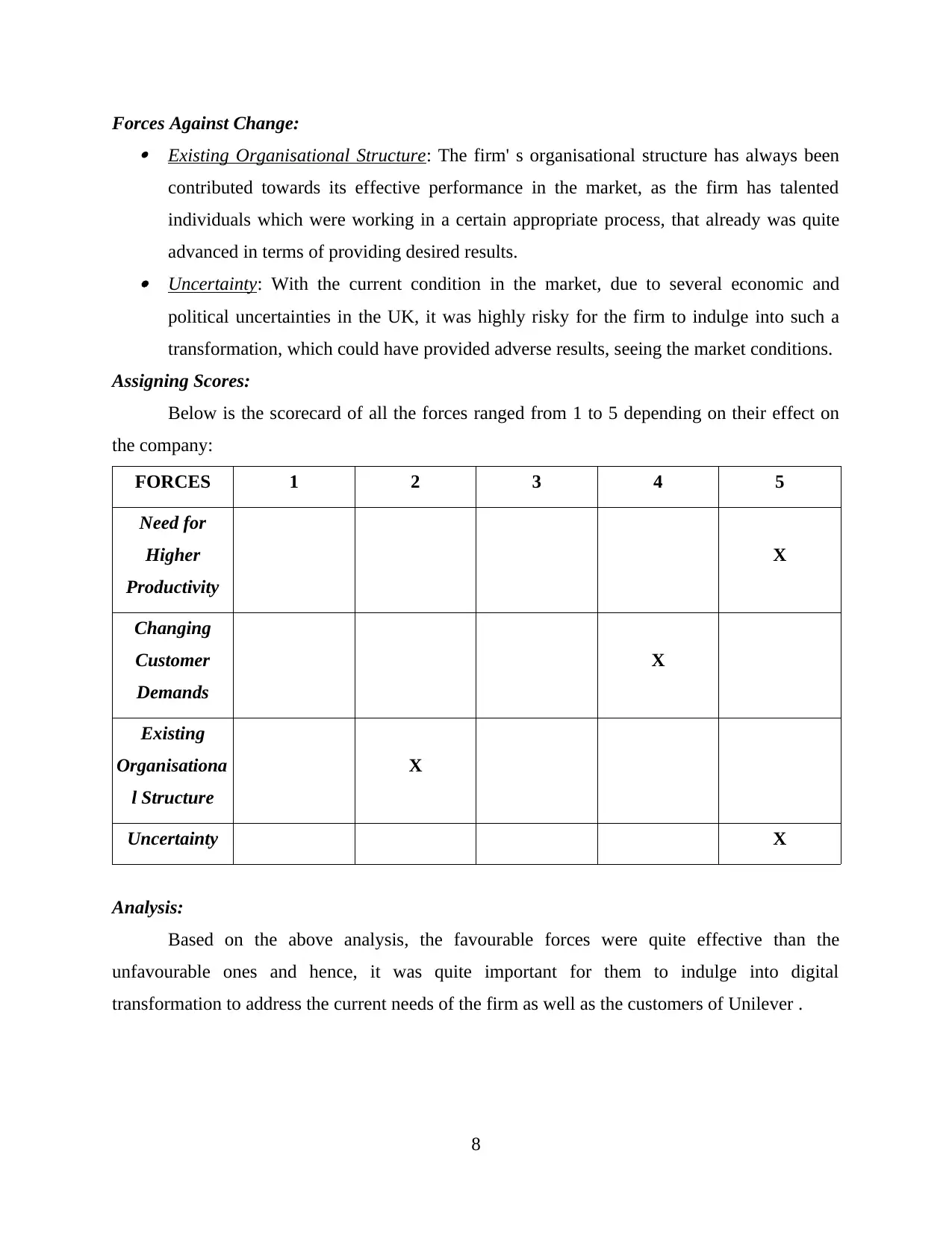
Forces Against Change: Existing Organisational Structure: The firm' s organisational structure has always been
contributed towards its effective performance in the market, as the firm has talented
individuals which were working in a certain appropriate process, that already was quite
advanced in terms of providing desired results. Uncertainty: With the current condition in the market, due to several economic and
political uncertainties in the UK, it was highly risky for the firm to indulge into such a
transformation, which could have provided adverse results, seeing the market conditions.
Assigning Scores:
Below is the scorecard of all the forces ranged from 1 to 5 depending on their effect on
the company:
FORCES 1 2 3 4 5
Need for
Higher
Productivity
X
Changing
Customer
Demands
X
Existing
Organisationa
l Structure
X
Uncertainty X
Analysis:
Based on the above analysis, the favourable forces were quite effective than the
unfavourable ones and hence, it was quite important for them to indulge into digital
transformation to address the current needs of the firm as well as the customers of Unilever .
8
contributed towards its effective performance in the market, as the firm has talented
individuals which were working in a certain appropriate process, that already was quite
advanced in terms of providing desired results. Uncertainty: With the current condition in the market, due to several economic and
political uncertainties in the UK, it was highly risky for the firm to indulge into such a
transformation, which could have provided adverse results, seeing the market conditions.
Assigning Scores:
Below is the scorecard of all the forces ranged from 1 to 5 depending on their effect on
the company:
FORCES 1 2 3 4 5
Need for
Higher
Productivity
X
Changing
Customer
Demands
X
Existing
Organisationa
l Structure
X
Uncertainty X
Analysis:
Based on the above analysis, the favourable forces were quite effective than the
unfavourable ones and hence, it was quite important for them to indulge into digital
transformation to address the current needs of the firm as well as the customers of Unilever .
8
Paraphrase This Document
Need a fresh take? Get an instant paraphrase of this document with our AI Paraphraser
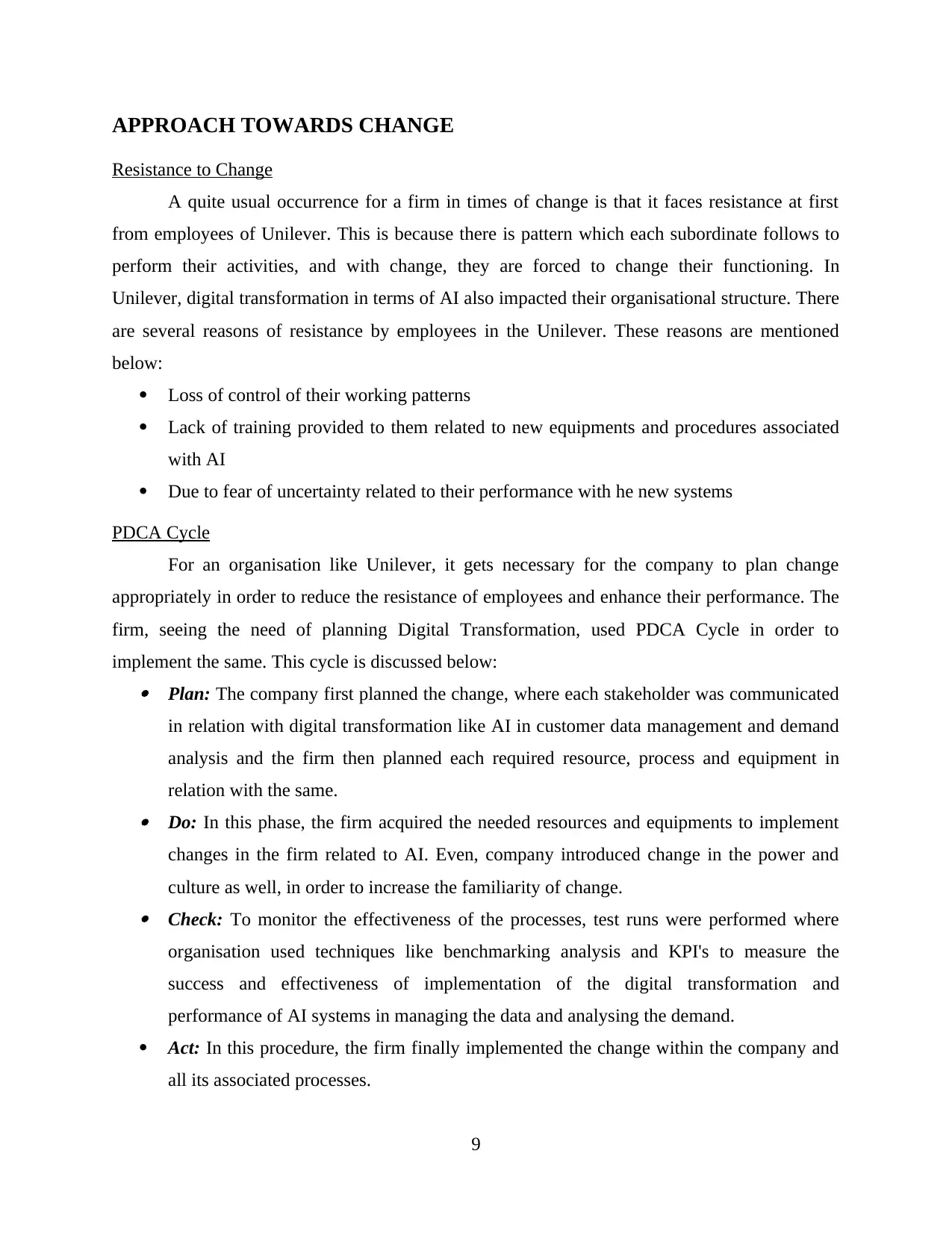
APPROACH TOWARDS CHANGE
Resistance to Change
A quite usual occurrence for a firm in times of change is that it faces resistance at first
from employees of Unilever. This is because there is pattern which each subordinate follows to
perform their activities, and with change, they are forced to change their functioning. In
Unilever, digital transformation in terms of AI also impacted their organisational structure. There
are several reasons of resistance by employees in the Unilever. These reasons are mentioned
below:
Loss of control of their working patterns
Lack of training provided to them related to new equipments and procedures associated
with AI
Due to fear of uncertainty related to their performance with he new systems
PDCA Cycle
For an organisation like Unilever, it gets necessary for the company to plan change
appropriately in order to reduce the resistance of employees and enhance their performance. The
firm, seeing the need of planning Digital Transformation, used PDCA Cycle in order to
implement the same. This cycle is discussed below: Plan: The company first planned the change, where each stakeholder was communicated
in relation with digital transformation like AI in customer data management and demand
analysis and the firm then planned each required resource, process and equipment in
relation with the same. Do: In this phase, the firm acquired the needed resources and equipments to implement
changes in the firm related to AI. Even, company introduced change in the power and
culture as well, in order to increase the familiarity of change. Check: To monitor the effectiveness of the processes, test runs were performed where
organisation used techniques like benchmarking analysis and KPI's to measure the
success and effectiveness of implementation of the digital transformation and
performance of AI systems in managing the data and analysing the demand.
Act: In this procedure, the firm finally implemented the change within the company and
all its associated processes.
9
Resistance to Change
A quite usual occurrence for a firm in times of change is that it faces resistance at first
from employees of Unilever. This is because there is pattern which each subordinate follows to
perform their activities, and with change, they are forced to change their functioning. In
Unilever, digital transformation in terms of AI also impacted their organisational structure. There
are several reasons of resistance by employees in the Unilever. These reasons are mentioned
below:
Loss of control of their working patterns
Lack of training provided to them related to new equipments and procedures associated
with AI
Due to fear of uncertainty related to their performance with he new systems
PDCA Cycle
For an organisation like Unilever, it gets necessary for the company to plan change
appropriately in order to reduce the resistance of employees and enhance their performance. The
firm, seeing the need of planning Digital Transformation, used PDCA Cycle in order to
implement the same. This cycle is discussed below: Plan: The company first planned the change, where each stakeholder was communicated
in relation with digital transformation like AI in customer data management and demand
analysis and the firm then planned each required resource, process and equipment in
relation with the same. Do: In this phase, the firm acquired the needed resources and equipments to implement
changes in the firm related to AI. Even, company introduced change in the power and
culture as well, in order to increase the familiarity of change. Check: To monitor the effectiveness of the processes, test runs were performed where
organisation used techniques like benchmarking analysis and KPI's to measure the
success and effectiveness of implementation of the digital transformation and
performance of AI systems in managing the data and analysing the demand.
Act: In this procedure, the firm finally implemented the change within the company and
all its associated processes.
9
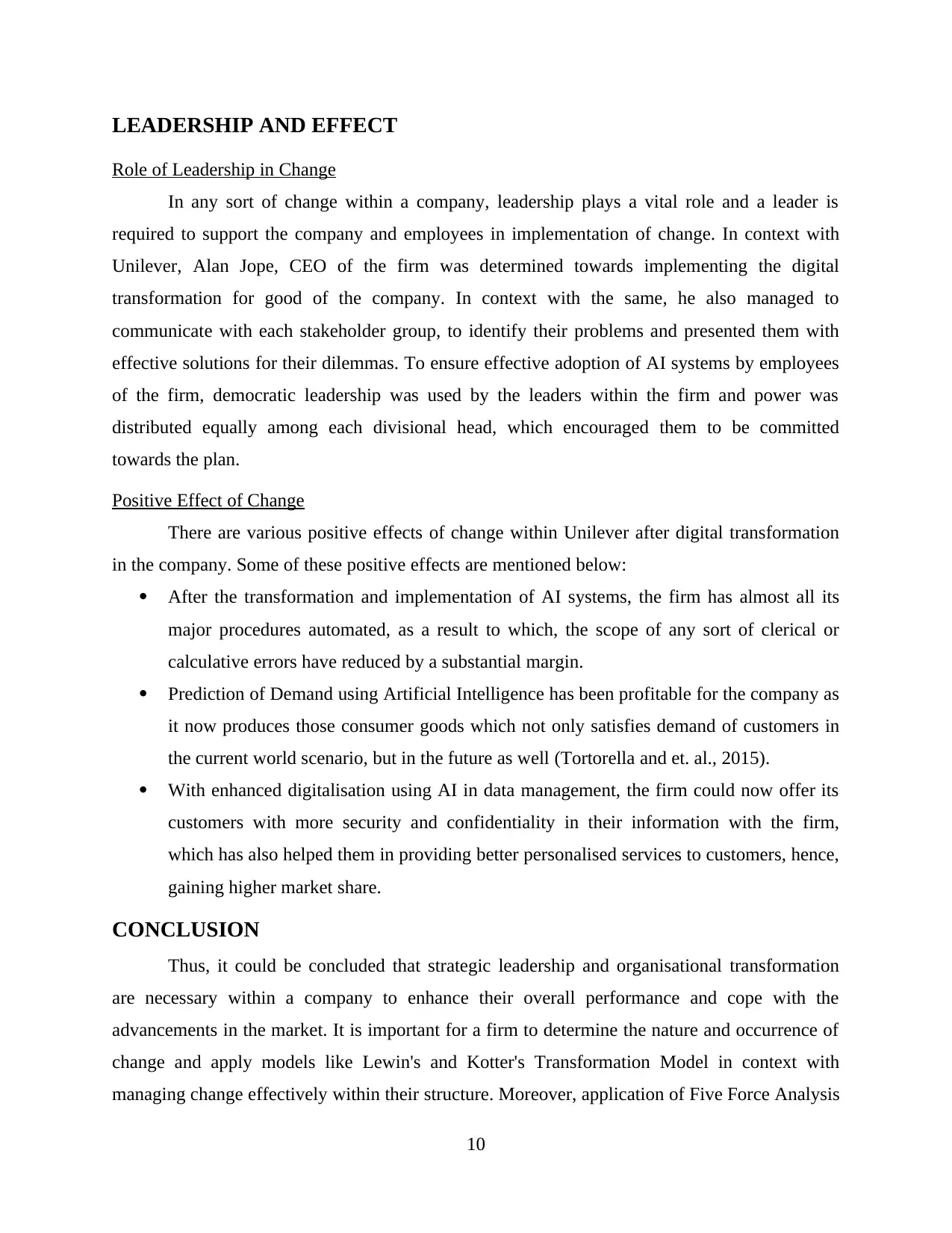
LEADERSHIP AND EFFECT
Role of Leadership in Change
In any sort of change within a company, leadership plays a vital role and a leader is
required to support the company and employees in implementation of change. In context with
Unilever, Alan Jope, CEO of the firm was determined towards implementing the digital
transformation for good of the company. In context with the same, he also managed to
communicate with each stakeholder group, to identify their problems and presented them with
effective solutions for their dilemmas. To ensure effective adoption of AI systems by employees
of the firm, democratic leadership was used by the leaders within the firm and power was
distributed equally among each divisional head, which encouraged them to be committed
towards the plan.
Positive Effect of Change
There are various positive effects of change within Unilever after digital transformation
in the company. Some of these positive effects are mentioned below:
After the transformation and implementation of AI systems, the firm has almost all its
major procedures automated, as a result to which, the scope of any sort of clerical or
calculative errors have reduced by a substantial margin.
Prediction of Demand using Artificial Intelligence has been profitable for the company as
it now produces those consumer goods which not only satisfies demand of customers in
the current world scenario, but in the future as well (Tortorella and et. al., 2015).
With enhanced digitalisation using AI in data management, the firm could now offer its
customers with more security and confidentiality in their information with the firm,
which has also helped them in providing better personalised services to customers, hence,
gaining higher market share.
CONCLUSION
Thus, it could be concluded that strategic leadership and organisational transformation
are necessary within a company to enhance their overall performance and cope with the
advancements in the market. It is important for a firm to determine the nature and occurrence of
change and apply models like Lewin's and Kotter's Transformation Model in context with
managing change effectively within their structure. Moreover, application of Five Force Analysis
10
Role of Leadership in Change
In any sort of change within a company, leadership plays a vital role and a leader is
required to support the company and employees in implementation of change. In context with
Unilever, Alan Jope, CEO of the firm was determined towards implementing the digital
transformation for good of the company. In context with the same, he also managed to
communicate with each stakeholder group, to identify their problems and presented them with
effective solutions for their dilemmas. To ensure effective adoption of AI systems by employees
of the firm, democratic leadership was used by the leaders within the firm and power was
distributed equally among each divisional head, which encouraged them to be committed
towards the plan.
Positive Effect of Change
There are various positive effects of change within Unilever after digital transformation
in the company. Some of these positive effects are mentioned below:
After the transformation and implementation of AI systems, the firm has almost all its
major procedures automated, as a result to which, the scope of any sort of clerical or
calculative errors have reduced by a substantial margin.
Prediction of Demand using Artificial Intelligence has been profitable for the company as
it now produces those consumer goods which not only satisfies demand of customers in
the current world scenario, but in the future as well (Tortorella and et. al., 2015).
With enhanced digitalisation using AI in data management, the firm could now offer its
customers with more security and confidentiality in their information with the firm,
which has also helped them in providing better personalised services to customers, hence,
gaining higher market share.
CONCLUSION
Thus, it could be concluded that strategic leadership and organisational transformation
are necessary within a company to enhance their overall performance and cope with the
advancements in the market. It is important for a firm to determine the nature and occurrence of
change and apply models like Lewin's and Kotter's Transformation Model in context with
managing change effectively within their structure. Moreover, application of Five Force Analysis
10
⊘ This is a preview!⊘
Do you want full access?
Subscribe today to unlock all pages.

Trusted by 1+ million students worldwide
1 out of 14
Related Documents
Your All-in-One AI-Powered Toolkit for Academic Success.
+13062052269
info@desklib.com
Available 24*7 on WhatsApp / Email
![[object Object]](/_next/static/media/star-bottom.7253800d.svg)
Unlock your academic potential
Copyright © 2020–2025 A2Z Services. All Rights Reserved. Developed and managed by ZUCOL.





